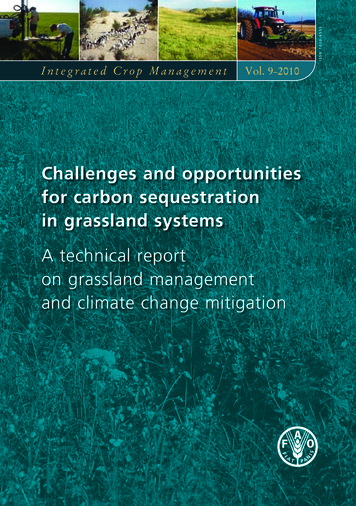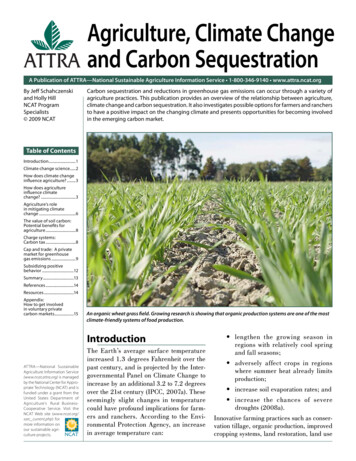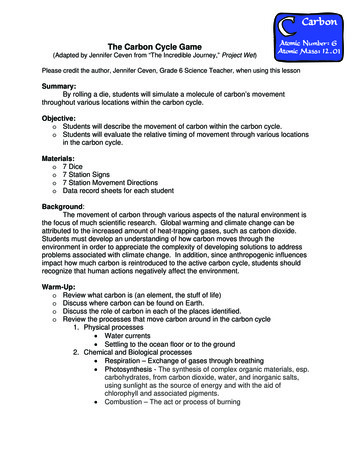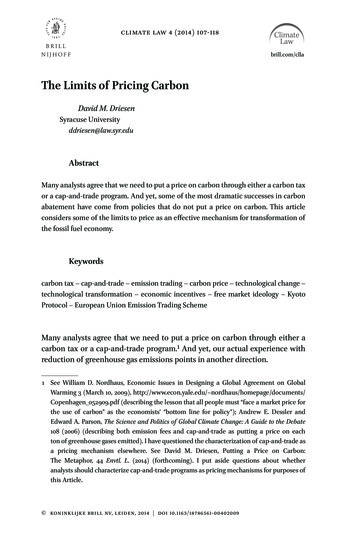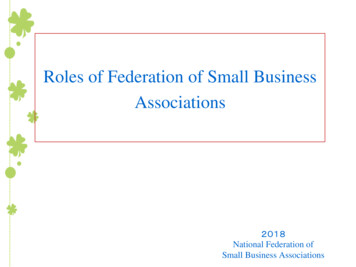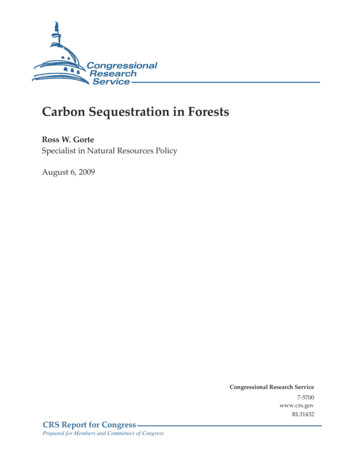
Transcription
Carbon Sequestration in ForestsRoss W. GorteSpecialist in Natural Resources PolicyAugust 6, 2009Congressional Research Service7-5700www.crs.govRL31432CRS Report for CongressPrepared for Members and Committees of Congress
Carbon Sequestration in ForestsSummaryWidespread concern about global climate change has led to interest in reducing emissions ofcarbon dioxide (CO2) and, under certain circumstances, in counting additional carbon absorbed insoils and vegetation as part of the emissions reductions. Congress may consider options toincrease the carbon stored (sequestered) in forests as it debates this and related issues.Forests are a significant part of the global carbon cycle. Plants use sunlight to convert CO2, water,and nutrients into sugars and carbohydrates, which accumulate in leaves, twigs, stems, and roots.Plants also respire, releasing CO2. Plants eventually die, releasing their stored carbon to theatmosphere quickly or to the soil where it decomposes slowly and increases soil carbon levels.However, little information exists on the processes and diverse rates of soil carbon change.How to account for changes in forest carbon has been contentious. Land use changes—especiallyafforestation and deforestation—can have major impacts on carbon storage. Foresters often cutsome vegetation to enhance growth of desired trees. Enhanced growth stores more carbon, but thecut vegetation releases CO2; the net effect depends on many factors, such as prior and subsequentgrowth rates and the quantity and disposal of cut vegetation. Rising atmospheric CO2 maystimulate tree growth, but limited availability of other nutrients may constrain that growth.In this context, timber harvesting is an especially controversial forestry practice. Some argue thatthe carbon released by cutting exceeds the carbon stored in wood products and in tree growth bynew forests. Others counter that old-growth forests store little or no additional carbon, and thatnew forest growth and efficient wood use can increase net carbon storage. The impacts varywidely, and depend on many factors, including soil impacts, treatment of residual forest biomass,proportion of carbon removed from the site, and duration and disposal of the products. To date,the quantitative relationships between these factors and net carbon storage have not beenestablished.Some observers are concerned that “leakage” will undermine any U.S. efforts to sequester carbonby protecting domestic forests. By leakage, they mean that wood supply might shift to other sites,including other countries, exacerbating global climate change and causing other environmentalproblems, or that wood products might be replaced by other products that use more energy tomanufacture (thus releasing more CO2). Others counter that the “leakage” arguments ignore theenormous disparity in ecological systems and product preferences, and discount possibletechnological solutions.Several federal government programs affect forestry practices and thus carbon sequestration.Activities in federal forests affect carbon storage and release; timber harvesting is the mostcontroversial such activity. Federal programs also provide technical and financial help formanaging and protecting private forests, and tax provisions affect private forest management.Various federal programs can also affect the extent of forested area, by supporting development(which may cause deforestation) or encouraging tree planting in open areas, such as pastures.Congressional Research Service
Carbon Sequestration in ForestsContentsBackground: Congressional Interest in Carbon Sequestration .1Carbon Cycling in Forests .2The Forest Cycle.3Forest Types.4Tropical Forests .5Temperate Forests .6Boreal Forests .6Measuring and Altering Forest Carbon Levels .6Forest Carbon Accounting.7Land Use Changes .8Forestry Events and Management Activities .9Vegetation and Soil Carbon .9Forest Events—Wildfires . 11Forestry Practices. 12Wood Energy . 16Leakage . 17Land Use Leakage . 17Product Demand Leakage . 18Federal Government Programs . 19Federal Forests. 19Federal Assistance for State and Private Forestry. 20Federal Tax Expenditures . 20Federal Programs Affecting Land Use . 21Accounting for Forest Carbon Sequestration . 22Conclusions . 22TablesTable 1. Average Carbon Stocks for Various Biomes.5ContactsAuthor Contact Information . 23Congressional Research Service
Carbon Sequestration in ForestsGlobal climate change is a widespread and growing concern that has led to extensiveinternational discussions and negotiations.1 Responses to this concern have focused onreducing emissions of greenhouse gases, especially carbon dioxide, and on measuringcarbon absorbed by and stored in forests, soils, and oceans. One option for slowing the rise ofgreenhouse gas concentrations in the atmosphere, and thus possible climate change, is to increasethe amount of carbon removed by and stored in forests. As Congress debates climate change andoptions for addressing the issue, ideas for increasing carbon sequestration in forests are likely tobe discussed.This report examines basic questions concerning carbon sequestration in forests. The first sectionprovides a brief background on congressional interest in forest carbon sequestration. The seconddescribes the basic carbon cycle in forests, with an overview of how carbon cycling and storagevary among different types of forests. The third section then addresses how forest carbon isconsidered in the global climate change debate. This third section begins with an overview ofaccounting for forest carbon, then discusses the carbon consequences of forest managementpractices, the effects of changes in land use, and “leakage.” The section then concludes with asummary of existing federal programs that could affect forest carbon sequestration.2Background: Congressional Interest inCarbon SequestrationThe widespread and growing concern over global climate change has led to extensiveinternational negotiations. In 1992, at the Earth Summit in Rio de Janeiro, the United NationsFramework Convention on Climate Change (which included voluntary pledges to reducegreenhouse gas emissions) was opened for signature. President George H. W. Bush signed thistreaty, which was then ratified by the U.S. Senate.Subsequent negotiations led to the 1997 Kyoto Protocol, under which the developed nationsagreed to specified reductions in their emissions of greenhouse gases. President Clinton signedthe Kyoto Protocol, but did not submit it to the Senate for ratification. Early in 2001, the GeorgeW. Bush Administration decided to reject the Kyoto Protocol, and withdrew from activeparticipation in negotiations on the issues that remain to be resolved. 3 Although enough otherparties have ratified the Protocol to bring it into force, the lack of U.S. involvement means thatthe United States will not participate in the emissions trading or other elements of the KyotoProtocol activities that might relate to carbon sequestration.The most voluminous greenhouse gas produced by humans is carbon dioxide (CO2). Incalculating overall carbon emissions, the Protocol allows certain removals of carbon by a nation’sforests and soils—“carbon sinks”—to be counted and deducted from emissions. Thus, one option1This report does not address underlying questions of whether global warming is occurring or of the possible humanrole. See CRS Report RL33849, Climate Change: Science and Policy Implications, by Jane A. Leggett.2This report does not address the impacts of climate change on forests, although this is also an important scientificissue. For a discussion of these impacts, see the series of articles in “A Special Section on Climate Change and ForestEcosystems,” Bioscience, v. 51, no. 9 (Sept. 2001): 720-779.3See CRS Report RL33826, Climate Change: The Kyoto Protocol, Bali “Action Plan,” and International Actions, byJane A. Leggett.Congressional Research Service1
Carbon Sequestration in Forestsfor mitigating greenhouse gas emissions—and thus possible climate change—is to increase theamount of carbon stored in forests.Carbon sequestration, and the extent to which it can be counted as a reduction in a nation’s carbonemissions, have been the focus of substantial controversy in international negotiations subsequentto the Kyoto Protocol.4 The United States, with its extensive forests, argued that the carbonabsorbed by them should be allowed to offset emissions, with no quantitative limit to the amountsthat can be counted in this way. The European Union argued strongly in negotiations prior to2001 that there should be fairly strict limits on how much carbon absorbed by “sinks” such asforests could be counted against emissions. In final negotiations during 2001 on rules toimplement the Kyoto Protocol, after the United States had withdrawn from the negotiations, acompromise was reached that allows significant credit for carbon sinks (removals and storage ofcarbon). The Members of Congress attending the negotiations prior to 2001 followed this debatewith interest, and were aware of the potential impacts of the various possible results of thenegotiations. In particular, if emissions trading were to begin under the Kyoto Protocol, forestowners and managers in countries that were parties to the treaty might be able to receive creditsand participate in the trading regime.Administration and congressional interest in carbon sequestration continues, but U.S.participation in the Kyoto process is moot at this time. It is not clear whether a domestic forestcarbon program might be established, although options have been discussed in legislativeproposals. Protecting forests in developing countries, which might earn credits under the KyotoProtocol, is already supported under the Tropical Forest Conservation Act (P.L. 105-214; 22U.S.C. §§2341, et seq.).5Mitigating climate change by enhancing forest carbon sequestration may be a relatively low-costoption and would likely yield other environmental benefits. However, forest carbon sequestrationfaces challenges: measuring the additional carbon stored (over and above what would occurnaturally); monitoring and verifying the results; and preventing leakage. Numerous issuesregarding the carbon cycle in forests, monitoring the levels and changes in forest carbon, and thescientific uncertainties about the relationships among forests, carbon, and climate change arelikely to be the subject of ongoing federal research efforts, with funding and oversight by theCongress.Carbon Cycling in ForestsPhotosynthesis is the chemical process by which plants use sunlight to convert nutrients intosugars and carbohydrates. Carbon dioxide (CO2) is one of the nutrients essential to building theorganic chemicals that comprise leaves, roots, and stems. All parts of a plant—the stem, limbsand leaves, and roots—contain carbon, but the proportion in each part varies enormously,depending on the plant species and the individual specimen’s age and growth pattern.Nonetheless, as more photosynthesis occurs, more CO2 is converted into biomass, reducingcarbon in the atmosphere and sequestering (storing) it in plant tissue (vegetation) above andbelow ground.4See CRS Report RS22806, The Bali Agreements and Forests, by Ross W. Gorte and Pervaze A. Sheikh.See CRS Report RL31286, Debt-for-Nature Initiatives and the Tropical Forest Conservation Act: Status andImplementation, by Pervaze A. Sheikh.5Congressional Research Service2
Carbon Sequestration in ForestsPlants also respire, using oxygen to maintain life and emitting CO2 in the process. At times (e.g.,at night and during winter seasons in non-tropical climates), living, growing forests are netemitters of CO2, although they are generally net carbon sinks over the life of the forest.When vegetation dies, carbon is released to the atmosphere. This can occur quickly, as in a fire,6or slowly, as fallen trees, leaves, and other detritus decompose. For herbaceous plants, the aboveground biomass dies annually and begins to decompose right away, but for woody plants, some ofthe above-ground biomass continues to store carbon until the plant dies and decomposes. This isthe essence of the carbon cycle in forests—net carbon accumulation (sequestration) withvegetative growth, and release of carbon when the vegetation dies. Thus, the amount of carbonsequestered in a forest is constantly changing with growth, death, and decomposition ofvegetation.In addition to being sequestered in vegetation, carbon is also sequestered in forest soils. Carbon isthe organic content of the soil, generally in the partially decomposed vegetation (humus) on thesurface and in the upper soil layers, in the organisms that decompose vegetation (decomposers),and in the fine roots.7 The amount of carbon in soils varies widely, depending on the environmentand the history of the site. Soil carbon accumulates as dead vegetation is added to the surface anddecomposers respond. Carbon is also “injected” into the soil as roots grow (root biomassincreases). Soil carbon is also slowly released to the atmosphere as the vegetation decomposes.Scientific understanding of the rates of soil carbon accumulation and decomposition is currentlynot sufficient for predicting changes in the amount of carbon sequestered in forest soils.The Forest CycleForests generally go through cycles of growth and death, sequestering and releasing carbon.Some forests begin on spacious sites, with little or no existing vegetation, that may have beencleared by a natural disaster (most commonly wildfire) or by human activities (e.g., foragriculture). Other forests are relatively continuous, with natural clearings typically limited to thearea occupied by one or a few large trees killed by lightning, disease, and such. Regardless of thesize or origin of a clearing, most forests begin from essentially bare land, with some carbon storedin the soil (how much depends on the environment and history of the site, especially the lastclearing process).As trees and other woody plants become established, carbon stored on the site increases as woodybiomass increases and as annual vegetation (e.g., tree leaves and herbaceous plants) typicallygrows faster than it decomposes. Productivity for commercially usable wood generally follows anS-shaped curve, with the volume growing at an increasing rate for many years, to a point knownto foresters as the culmination of mean annual increment (generally taking 20 to 100 years ormore, depending on the fertility of the site and the tree species), and then growing at a decreasingrate for many more years. In theory, forests can eventually become “over-mature,” where the lossof commercial volume through tree mortality equals or exceeds the additional growth on theremaining trees. However, one study has shown that some old-growth (“over-mature”) forestscontinue to accumulate carbon in their soils.86Fire is a self-sustaining chemical process that breaks organic chemicals down into minerals, water, and CO2.7Roots less than 2 millimeters in diameter are generally considered to be part of the soil, not part of the plant that grewthem.8Guoyi Zhou et al., “Old-Growth Forests Can Accumulate Carbon in Soils,” Science, v. 314 (Dec. 1, 2006): 1417.(continued.)Congressional Research Service3
Carbon Sequestration in ForestsThe relationship between commercially usable wood produced and carbon sequestered variessubstantially in three ways. First, the proportion of carbon in a tree’s commercial wood(compared to the noncommercial biomass in bark, limbs, roots, and leaves or needles) variesamong species; some (e.g., pines and other conifers) have a greater proportion of their totalcarbon in commercial wood.9 Second, the proportion of carbon in a tree’s commercial woodundoubtedly changes over time; while a temporal graph of carbon storage is probably also Sshaped (as for commercial wood productivity), the changes in timing and rates of increase (thatcause the characteristic S shape) almost certainly differ. Finally, a significant portion of thevegetative carbon sequestered in a forest is in other plants—noncommercial species of trees,shrubs, grasses, and other herbaceous plants. The amount of carbon stored in this other(noncommercial) growth varies widely among forests. Thus, although many research studiesassume a fixed relationship between commercial wood inventories and the amount of carbonstored,10 the traditional measures of commercial wood production might not be very accurate forestimating carbon sequestration in forests.Eventually, trees die. They may be cut down, burned in a wildfire, blown over or snapped off in awind or ice storm, or killed by insects or diseases. Death can happen to a single tree in a forest,creating a small opening, or to all or most trees in an area. How quickly the carbon is released tothe atmosphere depends on the cause of tree death, on whether it is harvested for use, and onvarious environmental factors. As noted above, fires quickly break down biomass and release anenormous amount of CO2 into the atmosphere. Natural death and decay may require severalweeks to several decades to completely decompose the biomass (depending on site conditions),putting some carbon into the soil and some directly into the atmosphere. Timber harvesting canstore some vegetative carbon for very long periods in solid wood products with long-term uses(e.g., construction lumber in houses), while tree tops and limbs and noncommercial species areleft to decay or to be burned. These possibilities are discussed in more depth below, under“Forestry Events and Management Activities.”Forest TypesCarbon sequestration and release vary substantially by forest. Nonetheless, some generalizationsare possible, because of the relative similarity of forests in specific “biomes”11—tropical,(.continued)Hereafter referred to as Zhou et al., “Soil Carbon in Old-Growth Forests.”9This is one reason why these species are preferred for timber plantations—a greater proportion of total biomassproduction goes into commercial wood, and is not “wasted” on noncommercial biomass.10One study—Paul Schroeder, “Can Intensive Management Increase Carbon Storage in Forests?” EnvironmentalManagement, v. 15, no. 4 (1991): 475-481, hereafter referred to as Schroeder, “Intensive Management for CarbonStorage”—assumed a “biomass expansion factor” of 1.6; that is, it assumed that total biomass was 60% greater than(1.6 times) the commercial wood biomass. Another study—Jack K. Winjum, Sandra Brown, and BernhardSchlamadinger, “Forest Harvests and Wood Products: Sources and Sinks of Atmospheric Carbon Dioxide,” ForestScience, v. 44, no. 2 (1998): 272-284—assumed biomass expansion factors of 1.3 for conifer forests and 2.0 for nonconifer forests. A third study—Robert J. Moulton and Kenneth R. Richards, Costs of Sequestering Carbon ThroughTree Planting and Forest Management in the United States, USDA Forest Service, Gen. Tech. Rept. WO-58,Washington, DC, Dec. 1990—used biomass expansion factors ranging from less than 2.0 to more than 8.0 just fordifferent forests within the United States.11A “biome” is defined as a “[r]egional land-based ecosystem type . characterized by consistent plant forms and .found over a large climatic area.” Examples include tropical rainforests, tundra, temperate grasslands, deserts, etc.From The Dictionary of Ecology and Environmental Science, Henry W. Art, ed., Henry Holt & Co., New York, NY,1993, p. 65.Congressional Research Service4
Carbon Sequestration in Foreststemperate, and boreal forests. Table 1 shows average carbon levels sequestered in vegetation andsoils for several major biomes, and the weighted average for all biomes. 12Table 1. Average Carbon Stocks for Various Biomes(in tons per acre)BiomePlantsSoilTotalTropical forests5455109Temperate forests254368Boreal forests29153182Tundra35760Croplands13637Tropical savannas135265Temp. 87306Weighted Average145973Source: Adapted from Intergovernmental Panel on Climate Change, “Table 1: Global carbon stocks invegetation and carbon pools down to a depth of 1 m [meter],” Summary for Policymakers: Land Use, Land-UseChange, and Forestry. A Special Report of the Intergovernmental Panel on Climate Change, at http://www.ipcc.ch/pub/srlulucf-e.pdf, p. 4.Tropical ForestsTropical forests are generally defined by their location—between the Tropic of Cancer and theTropic of Capricorn (23 north and south of the Equator, respectively). Some tropical forests arerelatively dry, open woodlands, but many receive heavy rains and are called moist or humidtropical forests; these are the classic rainforests, or “jungles.” Tropical forests contain anenormous diversity of “hardwood” tree species,13 and are difficult to categorize into “foresttypes,” because of this breadth of species diversity.Moist tropical forests are important for carbon sequestration, because they typically have highcarbon contents—averaging nearly 110 tons per acre. (See Table 1.) About half of the carbon in12Data on carbon stocks presented in this section are CRS calculations from data in Intergovernmental Panel onClimate Change, “Table 1: Global carbon stocks in vegetation and carbon pools down to a depth of 1 m [meter],”Summary for Policymakers: Land Use, Land-Use Change, and Forestry. A Special Report of the IntergovernmentalPanel on Climate Change, at http://www.ipcc.ch/pub/srlulucf-e.pdf. Hereafter referred to as IPCC, Special Report.13“Hardwoods” is a term commonly used for trees that are angiosperms—flowering plants—because the dominantflowering tree species of temperate climates (oaks and maples) are harder (more dense) than the major “softwood”species (pines, firs, and spruces), trees of the order Coniferales (conifers). However, some “hardwood” species (e.g.,aspen and poplar) are much softer (less dense) than many “softwoods.” In temperate areas, most hardwoods are alsodeciduous (losing all their leaves annually), while most conifers are evergreen (retaining their needles for more thanone year), leading to common use of “deciduous” and “evergreen” as synonyms for angiosperms and conifers.However, certain conifers (notably larches) are deciduous, while many hardwoods in subtropical climates and most intropical climates are evergreen. For this report, “hardwood” is used to indicate angiosperms, while “softwood” (orconifer) is used for coniferous species.Congressional Research Service5
Carbon Sequestration in Forestsmoist tropical forests is contained in the vegetation, a higher percentage and a much higherquantity than in any other biome. The remaining carbon is in tropical forest soils. Tropical forestsoils have only modest carbon levels (compared with other biomes), because the dead biomassrapidly decomposes in the warm, humid conditions and the minerals rapidly leach out of tropicalforest soils.Temperate ForestsTemperate forests typically occur in the mid-latitudes—generally to about 50 north and south ofthe Equator (a little farther north in Europe, because of the continental warming from the GulfStream). There are a large variety of temperate forests, including hardwood types (e.g., oakhickory and maple-beech-birch), softwood types (e.g., southern pine, Douglas-fir, and lodgepolepine), and a few mixed types (e.g., oak-pine). However, within each forest type, and overall,temperate forests have much lower tree species diversity than tropical forests.Temperate forests generally contain less carbon than tropical forests, averaging nearly 70 tons peracre. More than one-third of the carbon is stored in the vegetation, and nearly two-thirds in thesoil. The higher proportion (but lower level) in the temperate forest soils (compared to tropicalforest soils) is because of slower decomposition rates. Many of these forests are managed toproduce commercial wood products, and the management practices used in temperate forests canthus have a significant impact on carbon sequestration.Boreal ForestsBoreal forests generally occur north of temperate forests, mostly in Alaska, Canada, Scandinavia,and Russia. (The only boreal forests in the Southern Hemisphere are on mountaintops in NewZealand and high in the Andes Mountains of South America.) Boreal forests are dominated byconifers—mostly spruce, fir, and larch, with scattered birch and aspen stands.Boreal forests generally contain more carbon than temperate or tropical forests, averaging morethan 180 tons per acre. Less than one-sixth of boreal forest carbon is in vegetation. The rest, 84%,is in boreal forest soils—about three times the amount in temperate and tropical forests, and farhigher than any other biome except wetlands. 14 Carbon accumulates to high levels in boreal forestsoils because of the very slow decomposition rates, owing to the short summers and high acidityof conifer forest soils, both of which inhibit decomposition. The high boreal forest soil carbonlevel is important for carbon cycling, because many believe that management activities thatdisturb boreal forest soils can increase their release of carbon.Measuring and Altering Forest Carbon LevelsAside from the questions of whether climate change is occurring and whether human activitiesare the cause, the role of forestry and land use in mitigating climate change has been quitecontroversial. The disputes are largely the result of the scientific uncertainties in measuring14Soil carbon levels in wetlands are nearly double the level in boreal forests, because the frequent standing waterprevents aerobic decomposition, and anaerobic (without oxygen) decomposition processes are much slower thanaerobic processes.Congressional Research Service6
Carbon Sequestration in Forestschanging carbon levels in forests, changing land uses, and changing demand for products. Thissection summarizes forest carbon accounting concerns, possible consequences of changes in landuse and of forest management events and practices, “leakage,” and existing federal programsrelated to these concerns.Forest Carbon AccountingDifferent countries have various views on how to count carbon sequestered or released fromforests. In general, countries with extensive and expanding forests (e.g., Russia, Canada, Brazil,and the United States) prefer a full accounting, while countries with less forestland (e.g., manyEuropean countries) are concerned about the potential to overstate the carbon benefits of forestrymanagement practices and land use changes that enhance carbon sequestration. Countries withnet deforestation rates are also concerned about counting forest sequestration, because it couldeffectively increase their net emission rated under international agreements.Article 3.3 of the Kyoto Protocol allows counting the carbon effects (both sequestration andrelease) of afforestation, reforestation, deforestation, and other forestry and land use changes thathave occurred since 1990, if the change in carbon stock is verified. Verification requires a systemfor estimating the carbon effects—because a census of carbon changes on every forested acre isinfeasible—and for reporting the carbon effects.For countries with carbon commitments (rather than for projects), the surest, easiest system forverifying the change in carbon levels is to measure the change in the levels from the beginning tothe end of the relevant time period—1990 (the baseline) and 2008-2012 (the Kyoto Protocolcommit
Forests are a significant part of the global carbon cycle. Plants use sunlight to convert CO 2, water, and nutrients into sugars and carbohydrates, which accumulate in leaves, twigs, stems, and roots. . technological solutions. Several federal government programs affect forestry practices and thus carbon sequestration.
